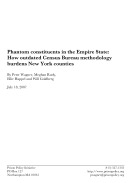
Importing Constituents:
Prisoners and Political Clout in Wisconsin
By John Hejduk and Peter Wagner
Prison Policy Initiative
March 2008
Section:
II. Counting incarcerated people as residents of prison towns skews demographic data
Counting incarcerated people as if they were residents of prison towns leads to misleading portrayals of such communities.
Wisconsin has the second highest Black incarceration rate in the country,[4] and the fifth highest racial disparity in incarceration,[5] with Blacks 10.6 times as likely to be in prison as Whites. Counties with large prisons, though, tend to be disproportionately White: 87% of the state and federal prison cells are located in counties that are have a larger White population than the state as a whole. In Dodge County, 89% and in Marquette County, 91%, of the Black population reported in the Census is not residents, but prisoners.[6]
The prison communities also tend to be small enough that incarcerated populations are a significant portion of the total "residents" counted by the Census. Twenty-four percent of the population reported in the Census for Waupun City (in Dodge and Fond du Lac Counties) is actually prisoners at the Waupun, Dodge and John C. Burke Correctional Facilities. About 5% of the "residents" counted in Dodge and Jackson Counties are actually prisoners. In Marquette County, more than 8% of "residents" are incarcerated.[8]
There is also a geographic disparity in who goes to prison in Wisconsin. The residents of Milwaukee, Racine, Kenosha and Rock counties are much more likely to be incarcerated than the residents of other counties. The residents of Milwaukee County are more than twice as likely to be in prison than the average resident of the state, and more than 7 times as likely as the residents of prison-hosting Dodge County. Milwaukee County contains 18% of the state population and is home for 42% of its prisoners.[7]
The Census Bureau's practice of counting prisoners as residents of the prison location complicates using the Census for demographic analysis of rural communities, but this problem is overshadowed by the serious damage the prisoner miscount does to state and local democracy.
Footnotes
[4] Mark Mauer and Ryan S. King, Uneven Justice: State Rates of Incarceration By Race and Ethnicity Table 3, 8 (July 2007).
[5] Mark Mauer and Ryan S. King, Uneven Justice: State Rates of Incarceration By Race and Ethnicity Table 6, 11 (July 2007).
[6] Peter Wagner, Outdated methodology impairs Census Bureau's count of Black population, Prisoners of the Census Fact of the Week for May 3, 2004.
[7] Calculated from Professor Pamela Oliver's Excel spreadsheets for Wisconsin county imprisonment rates data [XLS], and the U.S. Census 2000.
Events
- August 5, 2024:
On Wednesday, August 5, 2024, at 3 PM EST, we’ll host a panel of advocates to discuss the importance and challenges of helping people in prison testify at legislative hearings, and introduce our new legislative testimony toolkit.
Panelists include: Anthony Blakenship of Civil Survival, Jesse White of Prisoners’ Legal Services of Massachusetts, and incarcerated journalist Christopher Blackwell.
Register here.
Not near you?
Invite us to your city, college or organization.



